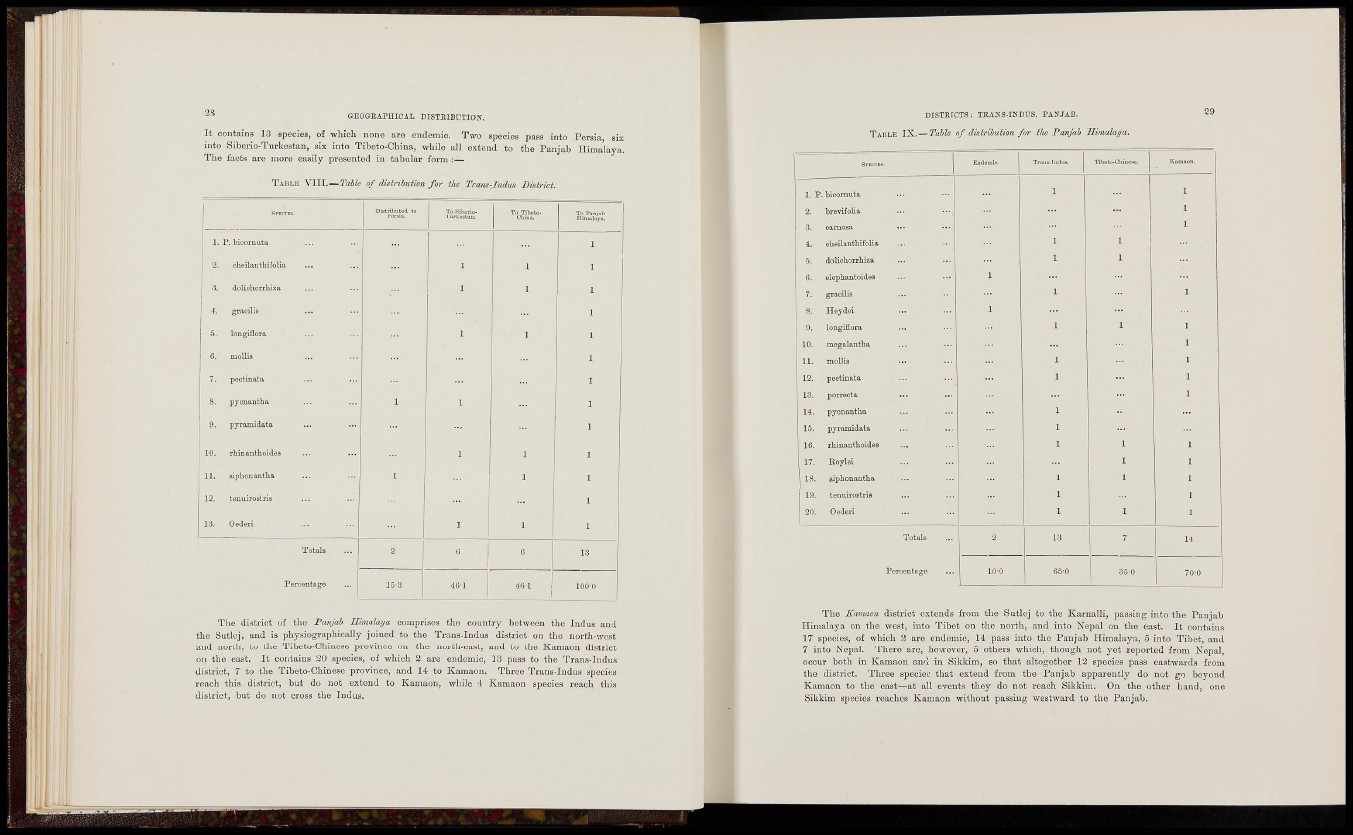
GEOGRAPHICAL DISTRIBUTION.
I t contains 13 species, of wKfcIi none are endemic. Two species pass into Persia, six
into Siberio-Turkestan, six into Tibeto-Chiua, while all extend to the Panjab Himalaya.
The facts are more easily presented in tabular form:—
TABLE VIII.—TAS^E of distribution for the Trans-Indus District.
Distributed to To Siborio-
Tvirkostan.
To Tiboto-
CbiDIl,
To Panjtib
Himnlayo.
1. p. "bicornuta 1
2. cheilanthitolia 1 1 1
1
dolichorrhiza 1 1 1
4, gracilis 1
5. longiflora 1 1 1
6. mollis 1
7. peotinata 1
8. pycnantba 1 1 1
9. pyramidata 1
10. rhinanthoidas 1 I 1
11. siphoDantha 1 I 1 1
12. tenuiroslris 1 1
13. Oederi I 1 1
Totals 2 ti 6 13
Percentage 15-3 46-1 461
1
1000
The district of the Pavjab Hinvtlaya comprises the country between the Indus and
the Sutlej, and is phyaiographically joined to the Trans-Indus district on the north-west
and north, to the Tibeto-Chinese province on the north-east, and to the Kamaon district
on the east. It contains 20 species, of -whicli 2 are endemic, 13 pass to the Trans-Indus
district, 7 to the Tibeto-Chinese province, and 14 to Kamaon. Three Trans-Indus species
reach this district, but do not extend to Kamaon, while 4 Kamaon species reach this
district^ bat do not cross the Indus.
DISTRICTS; TEANS-INDUS, PANJAC.
TABLE IX.—Tuhle of distribution for the Panjab Himalaya.
1. P. bieomuta
2. brevifolia
3. camos»
4. cheilantbi folia
5. dolichorrhiza
6,
elephantoidea
7.
gracilis
8. Heydei
9. longiflora
10. megalantha
11. mollis
12. pectinata
13. porrecta
14. pyonantha
15. pyramidata
16. thinanthoides
17. Roylei
18. siphonantha
19. tenuirostris
20. Oederi
Tiboto-Chinosa.
Percentage
The Kamaon district extends from tlie Sutlej to the Karnalli, passing into the Panjab
Himalaya on tlie west, into Tibet on the north, and into Nepal on the east. It contains
17 specics, of which 8 are ei-\dcmic, 14 pass into the Panjab Himalaya, 5 into Tibet, and
7 into Nepal. There are, however, 5 others which, though not yet reported from Nepal,
occur both in Kamaon anci in Sikkim, so that altogether 12 species pass eastwards from
the district. Three species: that extend from the Panjab apparently do not go beyond
Kamaon to the cast—at all events they do not reach Sikkim. On the other hand, one
Sikkim species reaches Kamaon without passing westward to the Panjab.